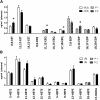Chiral lipidomics of monoepoxy and monohydroxy metabolites derived from long-chain polyunsaturated fatty acids
- PMID: 30409844
- PMCID: PMC6314268
- DOI: 10.1194/jlr.M089755
Chiral lipidomics of monoepoxy and monohydroxy metabolites derived from long-chain polyunsaturated fatty acids
Abstract
A chiral lipidomics approach was established for comprehensive profiling of regio- and stereoisomeric monoepoxy and monohydroxy metabolites of long-chain PUFAs as generated enzymatically by cytochromes P450 (CYPs), lipoxygenases (LOXs), and cyclooxygenases (COXs) and, in part, also unspecific oxidations. The method relies on reversed-phase chiral-LC coupled with ESI/MS/MS. Applications revealed partially opposing enantioselectivities of soluble and microsomal epoxide hydrolases (mEHs). Ablation of the soluble epoxide hydrolase (sEH) gene resulted in specific alterations in the enantiomeric composition of endogenous monoepoxy metabolites. For example, the (R,S)/(S,R)-ratio of circulating 14,15-EET changed from 2.1:1 in WT to 9.7:1 in the sEH-KO mice. Studies with liver microsomes suggested that CYP/mEH interactions play a primary role in determining the enantiomeric composition of monoepoxy metabolites during their generation and release from the ER. Analysis of human plasma showed significant enantiomeric excess with several monoepoxy metabolites. Monohydroxy metabolites were generally present as racemates; however, Ca2+-ionophore stimulation of whole blood samples resulted in enantioselective increases of LOX-derived metabolites (12S-HETE and 17S-hydroxydocosahexaenoic acid) and COX-derived metabolites (11R-HETE). Our chiral approach may provide novel opportunities for investigating the role of bioactive lipid mediators that generally exert their physiological functions in a highly regio- and stereospecific manner.
Keywords: chiral high-performance liquid chromatography; cytochrome P450; eicosanoids; lipoxygenase; microsomal epoxide hydrolase; oxylipins; soluble epoxide hydrolase; stereoisomers; tandem mass spectrometry.
Copyright © 2019 Blum et al.
Figures









Similar articles
-
Beyond detoxification: a role for mouse mEH in the hepatic metabolism of endogenous lipids.Arch Toxicol. 2017 Nov;91(11):3571-3585. doi: 10.1007/s00204-017-2060-4. Epub 2017 Oct 3. Arch Toxicol. 2017. PMID: 28975360 Free PMC article.
-
Triazine herbicide prometryn alters epoxide hydrolase activity and increases cytochrome P450 metabolites in murine livers via lipidomic profiling.Sci Rep. 2024 Aug 19;14(1):19135. doi: 10.1038/s41598-024-69557-3. Sci Rep. 2024. PMID: 39160161 Free PMC article.
-
Non-enantioselective, enantioselective, and two-dimensional liquid chromatography coupled with tandem mass spectrometry for the study of stereochemical disposition of oxylipins in cGMP-regulated hemin-treated platelets.J Pharm Biomed Anal. 2024 Sep 15;248:116328. doi: 10.1016/j.jpba.2024.116328. Epub 2024 Jun 26. J Pharm Biomed Anal. 2024. PMID: 38943819
-
Crosstalk between adenosine receptors and CYP450-derived oxylipins in the modulation of cardiovascular, including coronary reactive hyperemic response.Pharmacol Ther. 2022 Dec;240:108213. doi: 10.1016/j.pharmthera.2022.108213. Epub 2022 May 18. Pharmacol Ther. 2022. PMID: 35597366 Review.
-
Pathological and pharmacological functions of the metabolites of polyunsaturated fatty acids mediated by cyclooxygenases, lipoxygenases, and cytochrome P450s in cancers.Pharmacol Ther. 2024 Apr;256:108612. doi: 10.1016/j.pharmthera.2024.108612. Epub 2024 Feb 16. Pharmacol Ther. 2024. PMID: 38369063 Review.
Cited by
-
Exploring oxylipins in processed foods: Understanding mechanisms, analytical perspectives, and enhancing quality with lipidomics.Heliyon. 2024 Aug 9;10(16):e35917. doi: 10.1016/j.heliyon.2024.e35917. eCollection 2024 Aug 30. Heliyon. 2024. PMID: 39247353 Free PMC article. Review.
-
EPHX1 mutations cause a lipoatrophic diabetes syndrome due to impaired epoxide hydrolysis and increased cellular senescence.Elife. 2021 Aug 3;10:e68445. doi: 10.7554/eLife.68445. Elife. 2021. PMID: 34342583 Free PMC article.
-
The Octadecanoids: Synthesis and Bioactivity of 18-Carbon Oxygenated Fatty Acids in Mammals, Bacteria, and Fungi.Chem Rev. 2025 Jan 8;125(1):1-90. doi: 10.1021/acs.chemrev.3c00520. Epub 2024 Dec 16. Chem Rev. 2025. PMID: 39680864 Free PMC article. Review.
-
Development of a Chiral Supercritical Fluid Chromatography-Tandem Mass Spectrometry and Reversed-Phase Liquid Chromatography-Tandem Mass Spectrometry Platform for the Quantitative Metabolic Profiling of Octadecanoid Oxylipins.Anal Chem. 2022 Oct 25;94(42):14618-14626. doi: 10.1021/acs.analchem.2c02601. Epub 2022 Oct 11. Anal Chem. 2022. PMID: 36219822 Free PMC article.
-
Enantioselectivity Effects in Clinical Metabolomics and Lipidomics.Molecules. 2021 Aug 28;26(17):5231. doi: 10.3390/molecules26175231. Molecules. 2021. PMID: 34500665 Free PMC article. Review.
References
-
- Willenberg I., Ostermann A. I., and Schebb N. H.. 2015. Targeted metabolomics of the arachidonic acid cascade: current state and challenges of LC-MS analysis of oxylipins. Anal. Bioanal. Chem. 407: 2675–2683. - PubMed
-
- Schunck W. H., Konkel A., Fischer R., and Weylandt K. H.. 2018. Therapeutic potential of omega-3 fatty acid-derived epoxyeicosanoids in cardiovascular and inflammatory diseases. Pharmacol. Ther. 183: 177–204. - PubMed
Publication types
MeSH terms
Substances
LinkOut - more resources
Full Text Sources
Molecular Biology Databases
Research Materials
Miscellaneous

